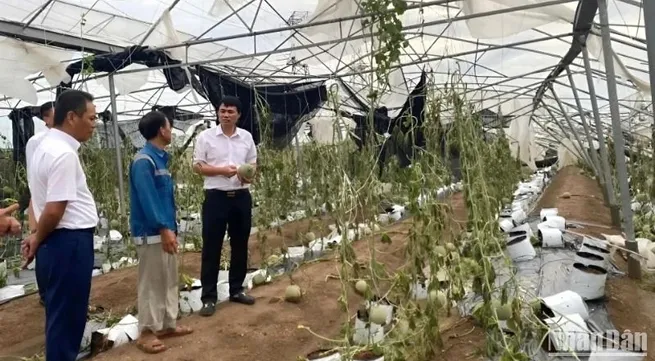Removing obstacles in mechanisms and policies to reduce bad debt pressure

These factors have further intensified bad debt pressure at banks, requiring additional solutions through mechanisms and policies.
Highlighting some challenges faced by the current credit institution system, Deputy Governor of the State Bank of Vietnam (SBV), Pham Quang Dung, noted that both bad debt and potential bad debt turning into bad debt have been increasing, with the risk rising further after the continued implementation of debt restructuring and maintaining the current debt group policies.
Increasing trend of bad debt
According to data from the State Bank of Vietnam, by the end of July 2024, the on-balance-sheet bad debt ratio of the credit institution system stood at 4.75%, up from 4.55% at the end of 2023 and 2.03% at the end of 2022. In this context, the risk of increasing bad debt in banks is significant, with SBV statistics showing that the damage caused by floods in northern provinces has reached 115 trillion VND. The damage figure is expected to increase as credit institutions and SBV branches continue to report, which could reach up to 1% of the total outstanding loans in the banking system.
Additionally, as of the end of June 2024, the total bad debt on balance sheets, unresolved bad debt at the Vietnam Asset Management Company (VAMC), and potential bad debt in the credit institution system accounted for 6.44% of total loans. According to the Bank Supervision and Inspection Agency (SBV), while this ratio has decreased from 6.9% at the end of 2023, it has risen from 4.21% at the end of 2022, exceeding the on-balance-sheet bad debt ratio of 4.56%, which credit institutions classify under Circular No. 11/2021/TT-NHNN, on asset classification, provisioning, and the use of provisions to handle risks in the activities of credit institutions and foreign bank branches.
Le Trung Kien, Deputy Director of Department 4 (Bank Supervision and Inspection Agency), pointed out the recent increase in bad debt at some credit institutions due to ongoing global economic instability, geopolitical conflicts in many countries, and uncontrolled inflation in some nations. Domestically, economic activities were significantly affected by the COVID-19 pandemic, natural disasters, and business conditions.
"This has led to a lack of stable recovery in business and production activities for enterprises and individuals, affecting their ability to repay bank loans," explained Le Trung Kien.
Sharing this view, Nguyen Quoc Hung, Vice Chairman and Secretary-General of the Vietnam Banks Association, stated that the prolonged impact of the COVID-19 pandemic, coupled with ongoing global and regional economic and social instability, has resulted in considerable difficulties for credit institutions, especially in handling bad debt.
Seeking solutions
In response to the potential rise in bad debt, leaders of many commercial banks have unanimously proposed that the SBV extend the debt restructuring and deferments period. According to Kim Byoungho, Chairman of the Board of Directors of HDBank, the bad debt ratio in the system remains high. Therefore, to support individuals and businesses affected by the storms, the government should consider extending the validity of Circular No. 06/2024/TT-NHNN on debt restructuring and maintaining debt groups beyond December 31, 2024, with more specific guidelines on debt deferrals and extensions.
Nguyen Hung, CEO of TPBank, also assessed that during the COVID-19 period, Circulars No. 01/2020/TT-NHNN and 02/2023/TT-NHNN, issued by the SBV regarding debt restructuring and deferments, were highly effective in providing immediate support to businesses and individuals. Based on this, he hopes the government and SBV will consider additional supportive policies, including debt deferrals, to help businesses gather resources and focus on recovering from storm damages, thereby stabilising production and business activities.
Ho Nam Tien, CEO of LPBank, proposed continuing the extension of Circular No. 02/2023/TT-NHNN on debt restructuring and maintaining debt groups while adding customers affected by storm No. 3 to those eligible for support. Similarly, Pham Toan Vuong, CEO of Agribank, suggested that the SBV extend debt restructuring mechanisms debt repayment terms, and maintain debt groups for customers affected by storms and floods based on the customers’ cash flow balance without limiting the disbursement time, and apply these measures to loans due before June 30, 2025.
Additionally, according to the opinions of many credit institution leaders, not only has bad debt increased, but recovery and handling of debt have also become increasingly difficult in the context of the expiration of National Assembly Resolution No. 42/2017/QH14 on the pilot handling of bad debts.
Data from the Bank Supervision and Inspection Agency show that in the first six months of 2024 alone, the system handled 167.3 trillion VND of bad debt, an increase of about 45.6% compared to last year. However, nearly half of that amount was handled by credit institutions internally through provisioning for risks. The seizure of collateral and bad debt recovery has been facing many challenges.
"Resolution No. 42/2017/QH14 has expired, but some of its provisions were not carried over into the Law on Credit Institutions 2024, especially regarding support from the police and local authorities in exercising the rights to seize and recover collateral for creditors," shared a leader of a commercial bank.
According to the Vietnam Banks Association, handling bad debts and collateral has encountered several key obstacles. These include issues related to the right to seize and liquidate collateral, the order of priority for payments from the proceeds of collateral sales, difficulties in applying expedited procedures during court litigation, challenges in handling and returning collateral used as evidence in criminal cases, as well as dealing with collateral in the form of shares, stocks, or future real estate developments. As a result, many have suggested that a stronger legal framework is needed to allow creditors to access and recover collateral for resolution.
Tags:





